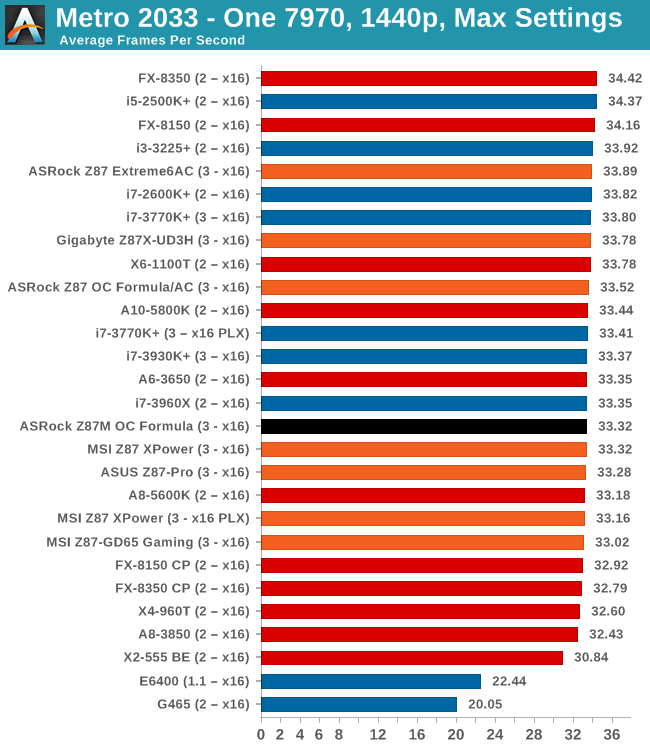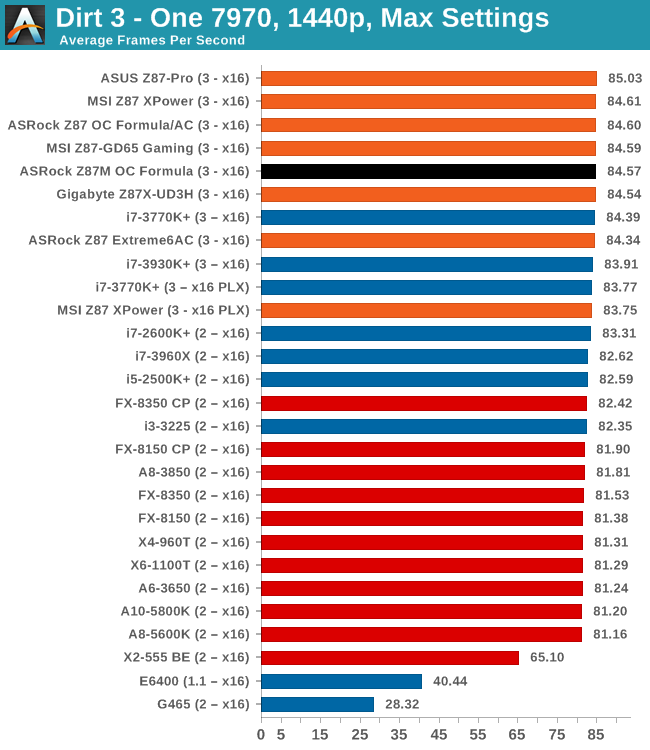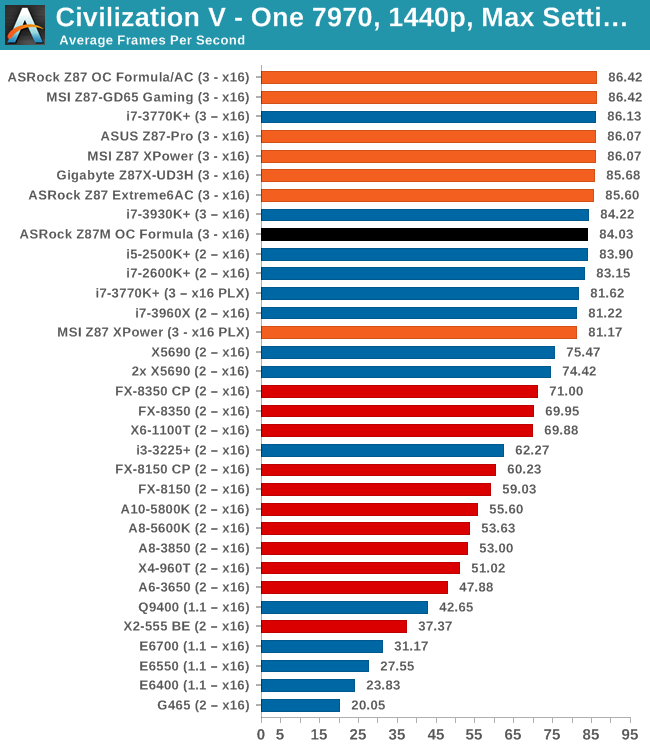ASRock Z87M OC Formula Review: mATX OC at $190
by Ian Cutress on August 14, 2013 10:00 AM EST- Posted in
- Motherboards
- ASRock
- Haswell
- Z87
Gaming Benchmarks
Metro2033
Our first analysis is with the perennial reviewers’ favorite, Metro2033. It occurs in a lot of reviews for a couple of reasons – it has a very easy to use benchmark GUI that anyone can use, and it is often very GPU limited, at least in single GPU mode. Metro2033 is a strenuous DX11 benchmark that can challenge most systems that try to run it at any high-end settings. Developed by 4A Games and released in March 2010, we use the inbuilt DirectX 11 Frontline benchmark to test the hardware at 1440p with full graphical settings. Results are given as the average frame rate from a second batch of 4 runs, as Metro has a tendency to inflate the scores for the first batch by up to 5%.

| Metro 2033 | 1 GPU | 2 GPU | |
| AMD | |||
| NVIDIA |
Dirt 3
Dirt 3 is a rallying video game and the third in the Dirt series of the Colin McRae Rally series, developed and published by Codemasters. Dirt 3 also falls under the list of ‘games with a handy benchmark mode’. In previous testing, Dirt 3 has always seemed to love cores, memory, GPUs, PCIe lane bandwidth, everything. The small issue with Dirt 3 is that depending on the benchmark mode tested, the benchmark launcher is not indicative of game play per se, citing numbers higher than actually observed. Despite this, the benchmark mode also includes an element of uncertainty, by actually driving a race, rather than a predetermined sequence of events such as Metro 2033. This in essence should make the benchmark more variable, but we take repeated in order to smooth this out. Using the benchmark mode, Dirt 3 is run at 1440p with Ultra graphical settings. Results are reported as the average frame rate across four runs.

| Dirt 3 | 1 GPU | 2 GPU |
| AMD | ||
| NVIDIA |
Civilization V
A game that has plagued my testing over the past twelve months is Civilization V. Being on the older 12.3 Catalyst drivers were somewhat of a nightmare, giving no scaling, and as a result I dropped it from my test suite after only a couple of reviews. With the later drivers used for this review, the situation has improved but only slightly, as you will see below. Civilization V seems to run into a scaling bottleneck very early on, and any additional GPU allocation only causes worse performance.
Our Civilization V testing uses Ryan’s GPU benchmark test all wrapped up in a neat batch file. We test at 1080p, and report the average frame rate of a 5 minute test.

| Civilization V | 1 GPU | 2 GPU |
| AMD | ||
| NVIDIA |
Sleeping Dogs
While not necessarily a game on everybody’s lips, Sleeping Dogs is a strenuous game with a pretty hardcore benchmark that scales well with additional GPU power due to its SSAA implementation. The team over at Adrenaline.com.br is supreme for making an easy to use benchmark GUI, allowing a numpty like me to charge ahead with a set of four 1440p runs with maximum graphical settings.

| Sleeping Dogs | 1 GPU | 2 GPU |
| AMD | ||
| NVIDIA |
Conclusions
In terms of gaming, MCT enabled or disabled does not seem to matter that much, except in Civilization V, where in dual GPU the M-OCF is 7 FPS behind the 112 scored by the normal OCF on AMD GPUs, and on one 7970 in Sleeping Dogs.










25 Comments
View All Comments
popej - Thursday, August 15, 2013 - link
If we talk about Haswell, then we could get about 4.0GHz on 4770 and 4.3-4.6GHz on 4770k. So it is rather 10% than 25%. I wonder what would be the comparison, if your task is able to effectively use TSX, which is missing in 4770k version?Will we see GPU drivers using TSX? Or games? Are you prepared to make a comparison?
fluxtatic - Monday, August 19, 2013 - link
Thank you, Intel, for artificially segmenting the lines.fluxtatic - Monday, August 19, 2013 - link
That first sentence is such a load. If you're any sort of enthusiast at all, you're not going to be buying a board with a business-oriented chipset. If you're not an idiot, you're going to buy decent RAM regardless - what extra expense are you talking about?psyside1 - Friday, August 23, 2013 - link
facepalm.jpgDanNeely - Wednesday, August 14, 2013 - link
A consumer use for the internal USB port might be bit-locker whole drive encryption. Truecrypt still doesn't officially support win8; and bit-locker requires one of a TPM (rare on consumer hardware), a USB drive as a keystore, or for the user to enter a 48 digit code (instead of a normal password) at each boot.I've never liked the idea of an external thumbstick even on a desktop; since you're one idiot borrowing it to copy data from being locked out of your box. An on-board port is a more elegant option than connecting an expansion slot brackets cable to an on board header but leaving the bracket in the case.
lcarros - Wednesday, August 14, 2013 - link
what does HDMI-In do?Rvenger - Wednesday, August 14, 2013 - link
I noticed you stated that the USB port is for a dongle for some software licenses. I interpret that the USB port is for cases that have a USB pass through cable instead of an actual 3.0 header.DanNeely - Wednesday, August 14, 2013 - link
It's a USB2 port (checked the manual); and USB2 pass throughs there have been mostly dead for a decade or so.Rvenger - Wednesday, August 21, 2013 - link
My bad, I should have noticed it wasn't blue.juhatus - Wednesday, August 14, 2013 - link
How does it compare agains the Asus Maximus VI gene or any other mATX Z87-board out there?I would really appreciate even a page about the competition..
Bitfenix prodigyM looks purrrfect for this :)